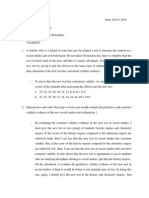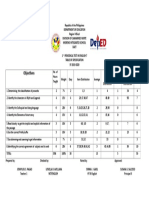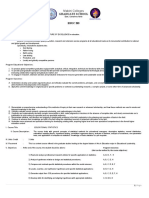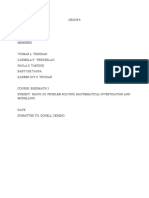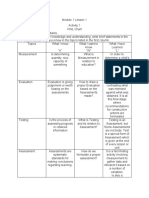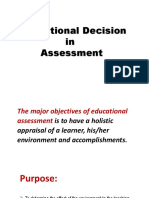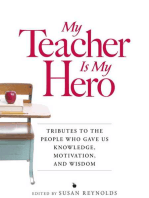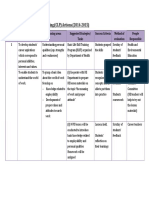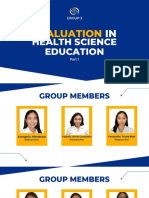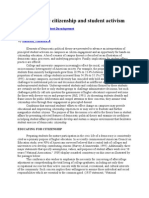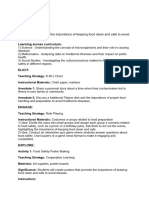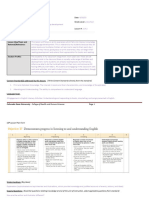0 ratings0% found this document useful (0 votes)
145 viewsUnit Assessment B
Unit Assessment B
Uploaded by
Ritchie MiguelThis document presents an activities matrix for assessing student learning in a unit. It outlines:
1) Big ideas, skills, and standards to be addressed through various formative and summative assessments.
2) How students' prior knowledge and experiences will be drawn on to connect them to the big ideas.
3) Instructional strategies like lectures, discussions and activities that will support students in meeting standards and understanding big ideas.
4) Resources like modules, presentations and samples that will best convey concepts and support skill development.
Copyright:
© All Rights Reserved
Available Formats
Download as DOCX, PDF, TXT or read online from Scribd
Unit Assessment B
Unit Assessment B
Uploaded by
Ritchie Miguel0 ratings0% found this document useful (0 votes)
145 views3 pagesThis document presents an activities matrix for assessing student learning in a unit. It outlines:
1) Big ideas, skills, and standards to be addressed through various formative and summative assessments.
2) How students' prior knowledge and experiences will be drawn on to connect them to the big ideas.
3) Instructional strategies like lectures, discussions and activities that will support students in meeting standards and understanding big ideas.
4) Resources like modules, presentations and samples that will best convey concepts and support skill development.
Original Title
UNIT-ASSESSMENT-B
Copyright
© © All Rights Reserved
Available Formats
DOCX, PDF, TXT or read online from Scribd
Share this document
Did you find this document useful?
Is this content inappropriate?
This document presents an activities matrix for assessing student learning in a unit. It outlines:
1) Big ideas, skills, and standards to be addressed through various formative and summative assessments.
2) How students' prior knowledge and experiences will be drawn on to connect them to the big ideas.
3) Instructional strategies like lectures, discussions and activities that will support students in meeting standards and understanding big ideas.
4) Resources like modules, presentations and samples that will best convey concepts and support skill development.
Copyright:
© All Rights Reserved
Available Formats
Download as DOCX, PDF, TXT or read online from Scribd
Download as docx, pdf, or txt
0 ratings0% found this document useful (0 votes)
145 views3 pagesUnit Assessment B
Unit Assessment B
Uploaded by
Ritchie MiguelThis document presents an activities matrix for assessing student learning in a unit. It outlines:
1) Big ideas, skills, and standards to be addressed through various formative and summative assessments.
2) How students' prior knowledge and experiences will be drawn on to connect them to the big ideas.
3) Instructional strategies like lectures, discussions and activities that will support students in meeting standards and understanding big ideas.
4) Resources like modules, presentations and samples that will best convey concepts and support skill development.
Copyright:
© All Rights Reserved
Available Formats
Download as DOCX, PDF, TXT or read online from Scribd
Download as docx, pdf, or txt
You are on page 1of 3
UNIT ASSESSMENT –ACTIVITIES MATRIX
Skills & Student and Assessment Instructional Resources
Big Ideas Standards Family (Formative & Strategies &
Knowledge Summative Material
What important How will you What is meaningful What instructional What
skills/standards draw on evidence that practices resources
What are the will stud students’ students will best
enduring and strategies will
ents ideas, have understood the support convey the
understandings/ learn, practice, interests big big ideas
essential students to meet the
or apply and ideas and reached standards and
questions to be the student will experiences proficiency on the concepts to
addressed? and grasp the big
be able to: to connect skills/standards? ideas? support skill
Explain how students to Formative Lesson one: attainment?
Why assess current the big L Module
student
trends in ideas? 1) Diagnostic -
learning? Course overview
assessment Lesson one: assessment based
and of student materials
How do Community building
accountability Students prior knowledge Diagnostic
teachers (introduce a partner)
influence share related to assessment
decide policy and course of
questions
on what practice in objectives Diagnostic course and
they have
and how to schools today. assessment objectives
about
assess (linked to course
assessment. 2) Brainstorm Powerpoint
student objectives)
Compare and of pres
learning? students’ prior Lesson two: entation on
contrast Diagnostic
assessments knowledge RSVP,
assessment
Interpretation and
“for” and “of” of of varied formative
assessment tools analysis of and
learning and module
justify their L2) Group diagnostic summative
objectives to
use in presentation assessment data assessment
determine
classrooms student prior on Ormrod graphic (Whittaker,
and knowledge organizer Brains 2002 based
schools. and L2 torm list of on
Collect and experience ) Quick write assessment tools Ormrod,
use multiple with on and 2000 cited
sources of assessment assessment categorize as “of” below)
information to tools and for learning and “for”
their app : learning
assess student lications. “What is one thing Guiding
learning you a Mini questions
Instructor re - for
Understand queries doing in your class lecture on RSVP, readings on
and use a students that is formative and standards
variety of about assessment for summative (se
informal and rationale for learning? assessment tools Unit
formal, conducting What is one thing planning
formative and a diagnostic you could Jigsaw activity on matrix and
summative assessment. be doing that is assessment types assignment
assessments Lesson two: assessment for (based on rubric with
to determine learning?” Ormrod reading) sample unit
progress and Students L3) Write your own planning
plan instruction use their EQ Quickwrite on matrices in
prior and objective Assessment specific
Explain and knowledge – Lesson Three subject
justi to peer areas (for
fy with brainstorm a critique Quickwri critique)
examples from st of various of UDT te on Standards
your own assessment L3 formative/summative Subject
teaching and tools. ) Quickwrite assessment Matter
the teaching Lesson on Standards
of others how three: formative/summative Small group and (provided
standards, assessment whole class by
assessment, Students L4 discussions using students)
curriculum, examine ) Quickwrite guiding Samples of
and instruction content on RS questions on the various
are standards in readings types of
integrated for their o Summative about standards standards
the purpose wn 1) Unit planning . used in
of supporting subject matrix interactive
student area. and rationale Interactive lecture lecture
learning. reveals on CIAS Texts
Students students links and standards, Or
Construct and write their ’ goals, mrod, J.
provide a own application of objectives and (2000)
rationale for a EQs and CIAS to a unit essential Assessing
variety of objectives design in questions
assessment Lesson four: their own subject -- Student
tools area. defining terms Learning,
(in Students This includes: and examining From
cluding rubrics bring in their of samples. Educational
or other own how standards, C, I, Psychology
scoring guides, ideas about and Pair activity ,3
portfolios, instruction A are integrated for – rd
quizzes, and and the 1) examine Ed., Merrill:
tests) in assessment purpose of state content Columbus
in supporting standards and Ohio
pecific subject discussing student learning eva
area the case. (how luate level of of
teaching and why select specificity
Apply concepts
of
reliability,
validity,
You might also like
- TCRC December EvaluationDocument53 pagesTCRC December EvaluationJomari FelisildaNo ratings yet
- Grade Level: 7 Quarter/Grading Period: SecondDocument3 pagesGrade Level: 7 Quarter/Grading Period: SecondLONo ratings yet
- Prof. ED 8Document4 pagesProf. ED 8Ellionore CosteloNo ratings yet
- Academic InterventionDocument51 pagesAcademic InterventionRitchie MiguelNo ratings yet
- TQ Fo FSDocument6 pagesTQ Fo FSShainah Melicano SanchezNo ratings yet
- Ed 107 PreDocument15 pagesEd 107 PreMay Pearl BernaldezNo ratings yet
- Principles and Strategies of TeachingDocument11 pagesPrinciples and Strategies of TeachingKa NaNo ratings yet
- IMs RubricDocument2 pagesIMs RubricLanvin De Laneau100% (1)
- Module 3 Ass 2.Document7 pagesModule 3 Ass 2.WENNELIE TEUMENo ratings yet
- Session Guide For Real NumbersDocument5 pagesSession Guide For Real NumbersFelix LlameraNo ratings yet
- Personal Communication Strategy: Aquino, Loren ADocument43 pagesPersonal Communication Strategy: Aquino, Loren AJessica Alparaz100% (1)
- Table of Specification Sy 2019-2020Document1 pageTable of Specification Sy 2019-2020Jennylou PagaoNo ratings yet
- Portfolio in Assessment of Student Learning 2Document21 pagesPortfolio in Assessment of Student Learning 2Jessa Mae Montenegro BacuganNo ratings yet
- Math-18 Course-Syllabus 2024Document18 pagesMath-18 Course-Syllabus 2024angelamarie.maranoNo ratings yet
- A Semi Detailed Lesson Plan For Grade 12 ABM in OrganizatioDocument5 pagesA Semi Detailed Lesson Plan For Grade 12 ABM in OrganizatiojoymaryannzNo ratings yet
- Educ 203 SyllabusDocument8 pagesEduc 203 Syllabusjasron09ryNo ratings yet
- Module 4 Lesson 2 and 3Document7 pagesModule 4 Lesson 2 and 3JM INOCENTE CALANAONo ratings yet
- AssessmentDocument3 pagesAssessmentJoTanlogonOcate-AmbongNo ratings yet
- Group 4 Assessment of LearningDocument3 pagesGroup 4 Assessment of LearningMark RowilNo ratings yet
- Department of Education: A Semi-Detailed Lesson Plan in Mathematics 9Document3 pagesDepartment of Education: A Semi-Detailed Lesson Plan in Mathematics 9Melvin AbolocNo ratings yet
- Bsedmathcurriculum EDITrevisedDocument19 pagesBsedmathcurriculum EDITrevisedJoni Czarina AmoraNo ratings yet
- LET Reviewer - PROFESSIONAL EDUCATION Part-26 (50 Items)Document14 pagesLET Reviewer - PROFESSIONAL EDUCATION Part-26 (50 Items)Dave BanquerigoNo ratings yet
- DLL-WK 6-LC 10,11Document10 pagesDLL-WK 6-LC 10,11New Life SchoolNo ratings yet
- Final Exam ACTIVITY 1, 2, 3 & 4Document14 pagesFinal Exam ACTIVITY 1, 2, 3 & 4Resheila MalaonNo ratings yet
- Educ-602 StatisticsDocument3 pagesEduc-602 Statisticsryan nableNo ratings yet
- Professional Education Final DrillsDocument220 pagesProfessional Education Final DrillsUser AdminNo ratings yet
- Decile For Ungrouped DataDocument3 pagesDecile For Ungrouped DataJoseph OprolodNo ratings yet
- Complementary, Supplementary LP - AmiraDocument4 pagesComplementary, Supplementary LP - AmiraKristel Ann VictorianoNo ratings yet
- History of Mathematics Reviewer Compilation of LessonDocument25 pagesHistory of Mathematics Reviewer Compilation of LessonLoraine Buen FranciscoNo ratings yet
- Research in Math MidtermDocument17 pagesResearch in Math MidtermJEREMIAS DE LA CRUZNo ratings yet
- DLP FormatDocument2 pagesDLP FormatSammy AngNo ratings yet
- Learning Assessment StrategiesDocument6 pagesLearning Assessment StrategiesErwin Y. CabaronNo ratings yet
- DLL FCPDocument2 pagesDLL FCPCece GregorioNo ratings yet
- Mathe 138 1 Task 3 & 4Document8 pagesMathe 138 1 Task 3 & 4nikko candaNo ratings yet
- Educ 9 Learning in Assessment 1: It Is Student CenteredDocument4 pagesEduc 9 Learning in Assessment 1: It Is Student CenteredRodel EsparragoNo ratings yet
- Unit 3: Authentic Assessment of The Affective Domain: Prepared By: Josie S. SarenoDocument6 pagesUnit 3: Authentic Assessment of The Affective Domain: Prepared By: Josie S. SarenoJosieyaNo ratings yet
- Unit Assessment Map-PermutationDocument4 pagesUnit Assessment Map-PermutationMaribeth Sebolino100% (1)
- Field Study 2Document2 pagesField Study 2Elmer Oblino AbainzaNo ratings yet
- NEW DLP Arithmetic SequenceDocument10 pagesNEW DLP Arithmetic SequenceAliyah Monique BenitezNo ratings yet
- ASL-1 Lesson4 Activity1 (Tampus)Document3 pagesASL-1 Lesson4 Activity1 (Tampus)Shyna Marie E. TampusNo ratings yet
- Final Examination Choose The Letter of The Best Answer.: Developmental Reading 1Document12 pagesFinal Examination Choose The Letter of The Best Answer.: Developmental Reading 1anthonyNo ratings yet
- Educ 106 Q2L1Document3 pagesEduc 106 Q2L1Keith Ernest AbalosNo ratings yet
- Alternative Assessment - EportfolioDocument4 pagesAlternative Assessment - EportfolioFrancis Oso PantinoNo ratings yet
- Selecting and Constructing Test Items and TasksDocument3 pagesSelecting and Constructing Test Items and Tasksdummy langNo ratings yet
- Classroom Assessment: F E C I C ADocument3 pagesClassroom Assessment: F E C I C AShaNe BesaresNo ratings yet
- Lesson Planning Product-Based Performance TaskDocument8 pagesLesson Planning Product-Based Performance TaskMaricarElizagaFontanilla-LeeNo ratings yet
- Asl 2 PresentationDocument9 pagesAsl 2 PresentationKenny BeeNo ratings yet
- Chapter 2 Summative Assessment of LearningDocument4 pagesChapter 2 Summative Assessment of LearningAiko Garrido100% (1)
- Cabellon CbarDocument21 pagesCabellon CbarAdi CabellonNo ratings yet
- Math Major's Thesis (Reviewed)Document57 pagesMath Major's Thesis (Reviewed)George Kevin TomasNo ratings yet
- Development, Validation and Acceptability of Modules in Philippine Literature For The Grade Seven StudentsDocument13 pagesDevelopment, Validation and Acceptability of Modules in Philippine Literature For The Grade Seven StudentsEthel Marie Casido BurceNo ratings yet
- Full BlownDocument7 pagesFull BlownHannah Angela FrancoNo ratings yet
- Chapter 1-Introduction To Non-Parametric StatisticsDocument10 pagesChapter 1-Introduction To Non-Parametric StatisticsMarben OrogoNo ratings yet
- Quarter I Proposed Multimodal Assessment Strategy On Reflective Learning Using The IDEA Instructional ProcessDocument3 pagesQuarter I Proposed Multimodal Assessment Strategy On Reflective Learning Using The IDEA Instructional ProcessGenna EstacioNo ratings yet
- Jemarah RabinaDocument4 pagesJemarah RabinaCristal Jane JaspeNo ratings yet
- Process in Developing and Using Rubrics Fro Alternative AssessmentDocument30 pagesProcess in Developing and Using Rubrics Fro Alternative Assessmentjeremyperegrino137No ratings yet
- Llano, Cristyline C. Learning Task#5 & JournalDocument15 pagesLlano, Cristyline C. Learning Task#5 & JournalcrisdayNo ratings yet
- My Teacher is My Hero: Tributes to the People Who Gave Us Knowledge, Motivation, and WisdonFrom EverandMy Teacher is My Hero: Tributes to the People Who Gave Us Knowledge, Motivation, and WisdonNo ratings yet
- Proposal of Career and Life Planning (CLP) Actions (2014 2015)Document11 pagesProposal of Career and Life Planning (CLP) Actions (2014 2015)zaiazwaNo ratings yet
- Principles and Strategies of Formative AssessmentDocument12 pagesPrinciples and Strategies of Formative AssessmentNestor O. DawatonNo ratings yet
- Evaluation in Health Science Education (Part 1)Document23 pagesEvaluation in Health Science Education (Part 1)Kayla Mae GaNo ratings yet
- Font License PDFDocument1 pageFont License PDFRitchie MiguelNo ratings yet
- Merr-C Society of The Word Foundation Inc.: Quantity Description of Merchandise Unit Price AmountDocument1 pageMerr-C Society of The Word Foundation Inc.: Quantity Description of Merchandise Unit Price AmountRitchie MiguelNo ratings yet
- Free Ielts Lesson - The General Writing Test - Task 2Document8 pagesFree Ielts Lesson - The General Writing Test - Task 2Ritchie MiguelNo ratings yet
- Gandhian Views On EducationDocument4 pagesGandhian Views On EducationBrahmankhanda Basapara HIGH SCHOOLNo ratings yet
- Lesson Plan: Abu Dhabi Indian School, Branch 1-Al WathbaDocument4 pagesLesson Plan: Abu Dhabi Indian School, Branch 1-Al WathbaFarida MangalorewalaNo ratings yet
- Thesis On Academic Performance of StudentsDocument7 pagesThesis On Academic Performance of Studentsmaggiecavanaughmadison100% (2)
- Prelim Exams in TTL 102 2nd Sem. 2023 24Document5 pagesPrelim Exams in TTL 102 2nd Sem. 2023 24Angel TulodNo ratings yet
- Training Evaluation Form 3Document3 pagesTraining Evaluation Form 3Mr KNo ratings yet
- READING 3 - Selected and Compiled - 2023Document88 pagesREADING 3 - Selected and Compiled - 2023Yến NguyễnNo ratings yet
- Bip Final 1 2 1Document4 pagesBip Final 1 2 1api-356299533No ratings yet
- Sharda Admission 2017Document8 pagesSharda Admission 2017winsoftNo ratings yet
- American Colonial ArchitectureDocument11 pagesAmerican Colonial ArchitectureCam Detera100% (1)
- Rubel Rana 26)Document4 pagesRubel Rana 26)Eng Rubel RanaNo ratings yet
- Lesson 22Document22 pagesLesson 22LANIE JANE BRUCALNo ratings yet
- Meaning of PragmatismDocument2 pagesMeaning of PragmatismAiza JamitoNo ratings yet
- Research ProposalDocument2 pagesResearch ProposalKlare TyNo ratings yet
- examSectionGuide113 - CutOff - 2020 01 18 03 05Document20 pagesexamSectionGuide113 - CutOff - 2020 01 18 03 05sudhakar80No ratings yet
- Papers Sss PDFDocument6 pagesPapers Sss PDFLinda Bianca Tugs TugsNo ratings yet
- Aes Sip 2023 2025Document19 pagesAes Sip 2023 2025Cassie Rey ShyneNo ratings yet
- Mpre RationaleDocument2 pagesMpre RationaleBem CervantesNo ratings yet
- Democratic Citizenship and Student ActivismDocument13 pagesDemocratic Citizenship and Student ActivismNeilNo ratings yet
- Arabic Paging 45Document5 pagesArabic Paging 45cristellbalingcasagNo ratings yet
- El14 Student Choice 2Document1 pageEl14 Student Choice 2api-256244210No ratings yet
- Lesson PlanDocument9 pagesLesson PlanCatherine Bacus PequitNo ratings yet
- Learning Management SystemDocument3 pagesLearning Management SystemDua EimanNo ratings yet
- A Common Curriculum For Welding and Cutting Courses in AgriculturDocument53 pagesA Common Curriculum For Welding and Cutting Courses in AgriculturNorazzah AbdullahNo ratings yet
- AP MELC IN GRADE 1 FinalDocument98 pagesAP MELC IN GRADE 1 FinalJethro DajeroNo ratings yet
- Introduction To Special EducationDocument7 pagesIntroduction To Special EducationAmy F. CabfeoNo ratings yet
- Guidance Asd 08-1Document5 pagesGuidance Asd 08-1api-252404660No ratings yet
- Oakdale Middle School 8th Grade Math SyllabusDocument4 pagesOakdale Middle School 8th Grade Math Syllabustree5215No ratings yet
- Academic Calendar 2018 LSUDocument3 pagesAcademic Calendar 2018 LSUHelder OliveiraNo ratings yet
- Cep Lesson Plan 2Document9 pagesCep Lesson Plan 2api-690650522No ratings yet
- Reflection About Learner - Centered Dimensions, Psychological Principles, Organizational and Management and Its Teaching Method / PedagogyDocument2 pagesReflection About Learner - Centered Dimensions, Psychological Principles, Organizational and Management and Its Teaching Method / PedagogyFebbie Angela DazoNo ratings yet


